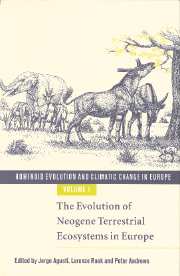Book contents
- Frontmatter
- Contents
- List of contributors
- Acknowledgements: The European Science Foundation
- 1 Introduction
- PART I Palaeogeography of the circum-Mediterranean region
- PART II Miocene mammalian successions
- PART III Palaeoenvironments: non-mammalian evidence
- 14 Marine invertebrate (chiefly foraminiferal) evidence for the palaeogeography of the Oligocene–Miocene of western Eurasia, and consequences for terrestrial vertebrate migration
- 15 Palaeoclimatic implications of the energy hypothesis from Neogene corals of the Mediterranean region
- 16 Contribution to the knowledge of Neogene climatic changes in western and central Europe by means of non-marine molluscs
- 17 Sedimentary facies analysis in palaeoclimatic reconstructions. Examples from the Upper Miocene–Pliocene successions of south-central Tuscany (Italy)
- 18 Neogene vegetation changes in West European and West circum-Mediterranean areas
- PART IV Palaeoenvironments: mammalian evidence
- Index
14 - Marine invertebrate (chiefly foraminiferal) evidence for the palaeogeography of the Oligocene–Miocene of western Eurasia, and consequences for terrestrial vertebrate migration
from PART III - Palaeoenvironments: non-mammalian evidence
Published online by Cambridge University Press: 15 December 2009
- Frontmatter
- Contents
- List of contributors
- Acknowledgements: The European Science Foundation
- 1 Introduction
- PART I Palaeogeography of the circum-Mediterranean region
- PART II Miocene mammalian successions
- PART III Palaeoenvironments: non-mammalian evidence
- 14 Marine invertebrate (chiefly foraminiferal) evidence for the palaeogeography of the Oligocene–Miocene of western Eurasia, and consequences for terrestrial vertebrate migration
- 15 Palaeoclimatic implications of the energy hypothesis from Neogene corals of the Mediterranean region
- 16 Contribution to the knowledge of Neogene climatic changes in western and central Europe by means of non-marine molluscs
- 17 Sedimentary facies analysis in palaeoclimatic reconstructions. Examples from the Upper Miocene–Pliocene successions of south-central Tuscany (Italy)
- 18 Neogene vegetation changes in West European and West circum-Mediterranean areas
- PART IV Palaeoenvironments: mammalian evidence
- Index
Summary
Introduction
Global palaeoclimate fluctuated cyclically during the Oligocene–Holocene, generally (though never irreversibly) deteriorating until the Pleistocene, which was characterised by widespread glaciation.
Eurasian palaeogeography was modified not only by associated (climatically induced) cyclic fluctuations in sea-level (glacio-eustasy) but also by mountain-building (tectonism) associated with the convergence between Arabia and Eurasia and the closure of the formerly intervening ocean known, after the daughter of the mythological earth-goddess Gaia, as Tethys (Suess, 1893). While Tethys, also known as the Tethyan Ocean or Seaway, was in existence, marine faunas were able to migrate between the Indo-Pacific and Mediterranean, and when it ceased to exist, terrestrial faunas were able to migrate between Africa and Eurasia.
This paper attempts to collate and integrate all the available marine invertebrate (chiefly foraminiferal) and associated evidence pertinent to the stratigraphy and palaeogeography of Western Eurasia over the critical Oligocene–Miocene interval, to describe the palaeogeographic evolution of the area during this time in the form of a series of time-slice maps, and to consider the consequences for terrestrial vertebrate migration.
Stratigraphy
The best-fit stratigraphic correlation that forms the basis for the time-slice identification and palaeogeographic mapping of the present paper is given in Fig. 14.1. Chronostratigraphy (global (Mediterranean)and regional (Indo-Pacific) stages), biostratigraphy (planktonic foraminiferal, calcareous nannoplankton and mammalian zones (and mammalian stages)), magnetostratigraphy, regional (Indian/Pakistani, Iranian and Paratethyan) lithostratigraphy, regional (Paratethyan) and global sequence stratigraphy, climatostratigraphy and palaeotemperature are all shown.
For the sake of consistency, I have attempted wherever possible to use biostratigraphy for the purposes of age assignment and stratigraphic correlation.
- Type
- Chapter
- Information
- Hominoid Evolution and Climatic Change in Europe , pp. 274 - 308Publisher: Cambridge University PressPrint publication year: 1999
- 7
- Cited by

